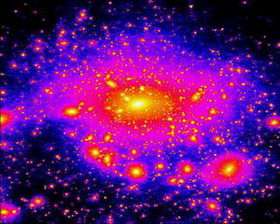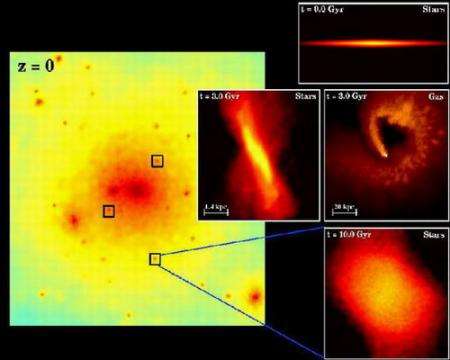Scientists Elucidate the Origin of the Darkest Galaxies in the Universe

Ghostly galaxies composed almost entirely of dark matter speckle the universe. Unlike normal galaxies, these extreme systems contain very few stars and are almost devoid of gas. Most of the luminous matter, so common in most galaxies, has been stripped away, leaving behind a dark matter shadow. These intriguing galaxies-known as dwarf spheroidals-are so faint that, although researchers believe they exist throughout the universe, only those relatively close to Earth have ever been observed.
And until recently, no scientific model proposed to unravel their origin could simultaneously explain their exceptional dark matter content and their penchant for existing only in close proximity to much larger galaxies.
Now, Stelios Kazantzidis, a researcher at Stanford University's Kavli Institute for Particle Astrophysics and Cosmology (KIPAC), in collaboration with Lucio Mayer of the Swiss Federal Institute of Technology in Zurich and the University of Zurich, Chiara Mastropietro of the University of Munich in Germany and James Wadsley of McMaster University in Canada, has developed an elegant explanation for how galaxies come to be dominated by dark matter. Kazantzidis, who completed part of the study as a fellow at the University of Chicago's Kavli Institute for Cosmological Physics, reports his findings in the Feb. 15 issue of Nature.
"These results are so exciting because they are based on a combination of physical effects that has never before been postulated," said Kazantzidis. "This is one step toward a more complete understanding of the formation of structure in the universe, which is one of the fundamental goals of astrophysics."

Using supercomputers to create novel simulations of galaxy formation, Kazantzidis and his collaborators found that a dark matter-dominated galaxy begins life as a normal system. But when it approaches a much more massive galaxy, it simultaneously encounters three environmental effects-"ram pressure," "tidal shocking" and the cosmic ultraviolet background-that transform it into a mere dark-matter shadow of its former self.
About 10 billion years ago, when the gas-rich progenitors of dark matter-dominated galaxies originally fell into the Milky Way, the universe was hot with a radiation called the cosmic ultraviolet background. As a small satellite galaxy traveled along its elliptical path around a more massive galaxy, called the host, this radiation made the gas within the smaller galaxy hotter. This state allowed ram pressure-a sort of "wind resistance" a galaxy feels as it speeds along its path-to strip away the gas within the satellite galaxy.
Simultaneously, as the satellite galaxy moved closer to the massive system, it encountered the overwhelming gravitational force of the much larger mass. This force wrenched luminous stars from the small galaxy. Over billions of years of evolution, the satellite passed by the massive galaxy several times as it traversed its orbital path. Each time its stars shook and the satellite lost some of them as a result of a mechanism called tidal shocking. These effects conspired to eventually strip away nearly all the luminous matter-gas and stars-and left behind only a dark-matter shadow of the original galaxy.
The dark matter, on the other hand, was nongaseous and therefore unaffected by the ram pressure force or the cosmic ultraviolet background, the scientists posit. It did experience tidal shocking, but this force alone was not strong enough to pull away a substantial amount of dark matter.
The numerical simulations conducted by Kazantzidis and his collaborators constitute the most extensive calculations ever performed on this topic, consuming up to two months of supercomputing time each at the University of Zurich, the Pittsburgh Supercomputing Center and elsewhere.
"Computer models of galaxy formation in the last decade or so have focused on modeling the properties of dark matter rather than those of the more familiar baryonic [luminous] matter," said co-author Mayer. "Instead, our work suggests that we cannot understand the origin of galaxies without modeling the detailed physics of baryonic matter, even in a dark matter-dominated universe."
The scientists say this new understanding of the origin of the darkest galaxies in the universe may soon lead to fundamental insights into the nature of dark matter.
"Elucidating the nature of dark matter is one of the grandest challenges of modern cosmology," said Kazantzidis. "In the next several years, numerous experiments will attempt to detect dark matter using dwarf spheroidal galaxies as targets." Kazantzidis' work will benefit these studies by offering a better explanation of the origin of ghostly galaxies.
Mystery of the missing satellites
Additionally, the work may help to explain a long-standing discrepancy between theory and observation. The leading modern cosmological model, Lambda Cold Dark Matter (ΛCDM), predicts that many more small galaxies surround massive galaxies like the Milky Way and Andromeda than are currently observed. This mismatch, which is often referred to as the "missing satellites problem," has been traditionally regarded as one of the toughest challenges to the (CDM paradigm. Kazantzidis' work suggests that the process by which small galaxies are stripped of their luminous matter is common, and implies that the "missing" galaxies could exist in the form of dark matter-dominated satellites.
"These galaxies could just be too dark to detect," he said. "But their possible existence will substantially alleviate the missing satellites problem with profound implications for the predictive power of the (CDM theory." Coincidentally, in the last few months, one of the most advanced observational programs ever undertaken, the Sloan Digital Sky Survey, has revealed in the vicinity of the Milky Way a number of what appear to be ultra-faint satellite galaxies. If this finding is confirmed by follow-up observations and analysis, these newly discovered systems would be explained by Kazantzidis' calculations and would contribute to solving the long-standing missing satellites problem, he says.
Source: Stanford University




















